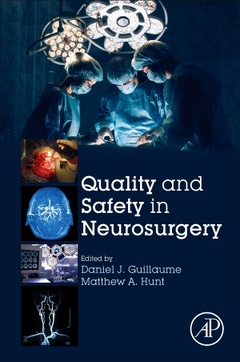Quality and Safety in Neurosurgery
Coordonnateurs : Guillaume Daniel J., Hunt Matthew A.

Quality and Safety in Neurosurgery covers recent improvements and presents solutions for problems that impact patient care. This book is written for anyone who works at the intersection of quality, safety and neurosurgery, including neurosurgeons, neurologists, clinical researchers looking to improve outcomes in neurosurgery, hospital quality and safety officers, department leaders, fellows and residents. Edited by neurosurgeons who helped build the culture of quality and safety in the Department of Neurosurgery at UMN, this work emphasizes quality and safety, whether through ?value based purchasing?, finding specialty specific quality and safety metrics, or just the professional desire to provide quality care.
Section I. The Importance of Quality and Safety in Neurosurgery 1. The many perspectives of quality and safety in neurosurgery 2. The history and future of quality and safety in neurosurgery 3. Clinical research in quality improvement: Complimentary approaches to improving neurosurgical practice
Section II. Measuring and Improving Performance 4. On developing the tools and metrics for a neurosurgical quality program 5. The role of clinical registries in health care 6. Measuring value of healthcare: The importance and challenges of measuring true cost 7. Teams, competence and safety in surgery 8. Evidenced-based practice of neurosurgery: Implications for quality and safety 9. The physician handoff and its role in quality and safety
Section III. The Practice of Quality and Safety in Neurosurgery 10. Improving operating room safety 11. Using multi-center clinical registries to improve outcomes 12. Improving efficiency and mapping surgical procedures using lean methods 13. Quality efforts for reducing mortality in neurosurgery 14. Reducing readmissions 15. Improving outcomes: Big data and predictive analytics 16. Improving performance by improving education 17. Improving outcomes with subspecialization and regionalization 18. Quality of care and outcomes in pediatric neurosurgery: Incorporating evidence-based practice 19. Eliminating unnecessary diagnostic imaging and labs 20. Creating national practice standards through collaboration 21. Use of risk model for assessment of resident perception of surgical complexity and evaluation of procedural competence 22. Use of physical education and nutrition program to improve outcomes
neurosurgeons, neurologists, clinical researchers looking to improve outcomes in neurosurgery, quality and safety officers, department leaders, and residents.
Dr. Hunt is an Associate Professor in the Department of Neurosurgery at the University of Minnesota. He is a Neurosurgeon, at the University of Minnesota Medical Center, Fairview. He is also the residency program director, helping to train the next generation of neurosurgical leaders. Dr. Hunt is the course director for the NeuroSafe symposium series focused on quality and safety in neurosurgery. His research interests involve novel treatments including immunotherapy for brain tumors and treating pet dogs with brain tumors as a model for treatment of human brain tumors. He collaborates with other researchers at the U of M to develop innovative treatments for patients with gliomas and meningiomas. His clinical interests include brain tumors and complex spinal surgery. He trained at Oregon Health & Science University and did fellowships there and at the National Hospital for Neurology and Neurosurgery in London, UK.
- Presents an overview of quality and safety in neurosurgical settings and discusses solutions for problems that impact patient care
- Gives readers the tools they need to improve quality and safety in neurosurgery
- Provides examples on how to implement new tactics
- Includes coverage on teams, competence, safety, hospital incentives, quality, the physician handoff, medication compliance and operating room efficiency, and more
Date de parution : 02-2018
Ouvrage de 314 p.
15x22.8 cm
Thème de Quality and Safety in Neurosurgery :
Mots-clés :
ACGME; Artificial intelligence; Big data; Burnout; Caseload; Checklists; Child health; Clinical practice guidelines; Clinical research; Collaboration; Collective competence; Communication; Competence; Cost; Cost-effectiveness; Crew-resource management; Culture; Culture of safety; Database; Database research; Digital phenotyping; Documentation; Efficiency; Error reporting; Errors; Evidence-based medicine; Experience; Fitness; Handoff; Handover; Head CT; Health; Health care; Health spending; Hospital readmissions; Hospital volume; Implant infections; Intrathecal baclofen therapy; Lean production; Machine learning; Metrics; Mortality; Mortality and morbidity (MandM); Mortality index; Multicenter; National databases; Natural language processing; Neuromonitoring; Neurosurgery; Neurosurgery fellowship; Neurosurgery quality and safety; Neurosurgery training; Noise vs bias; Nontechnical skills; NOTECH; NOTSS; Operative performance; Outcome improvement; Outcomes research; Patient care; Patient reported outcomes; Patient safety; Patient-centered; PDSA cycles; Pediatric neurosurgery; Performance measures; Postoperative imaging; Pragmatic registry-based observational studies; Process improvement; Process map; Protocols; Psychological impact; Quality; Quality improvement; Quality improvement (QI); Quality initiatives; Quality Outcomes Database; Randomized controlled trial; Reducing costs; Regionalization; Registries; Research; Residency education; Resident education; Risk matrix; Safety; Safety attitudes questionnaire; Simulation; Simulation training; Standards; Study designs; Subspecialty training; Surgical site infections; Survey; Teaming; Teams; Teamwork; Time-driven activity-based costing; Transitions of care; UHC; Value; Volume-outcome relationships; Volume-outcomes relationship; Waste reduction; Wellness



